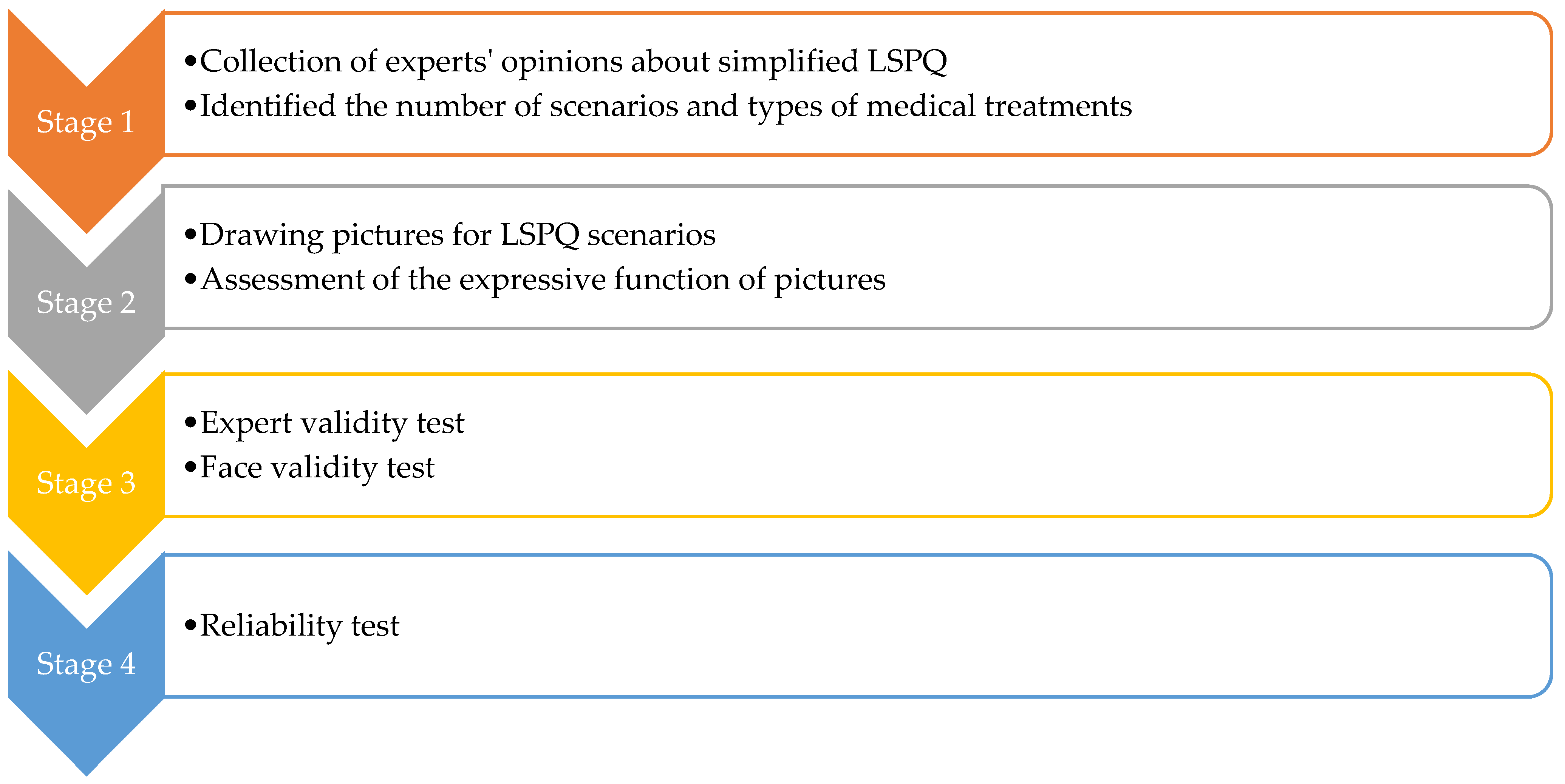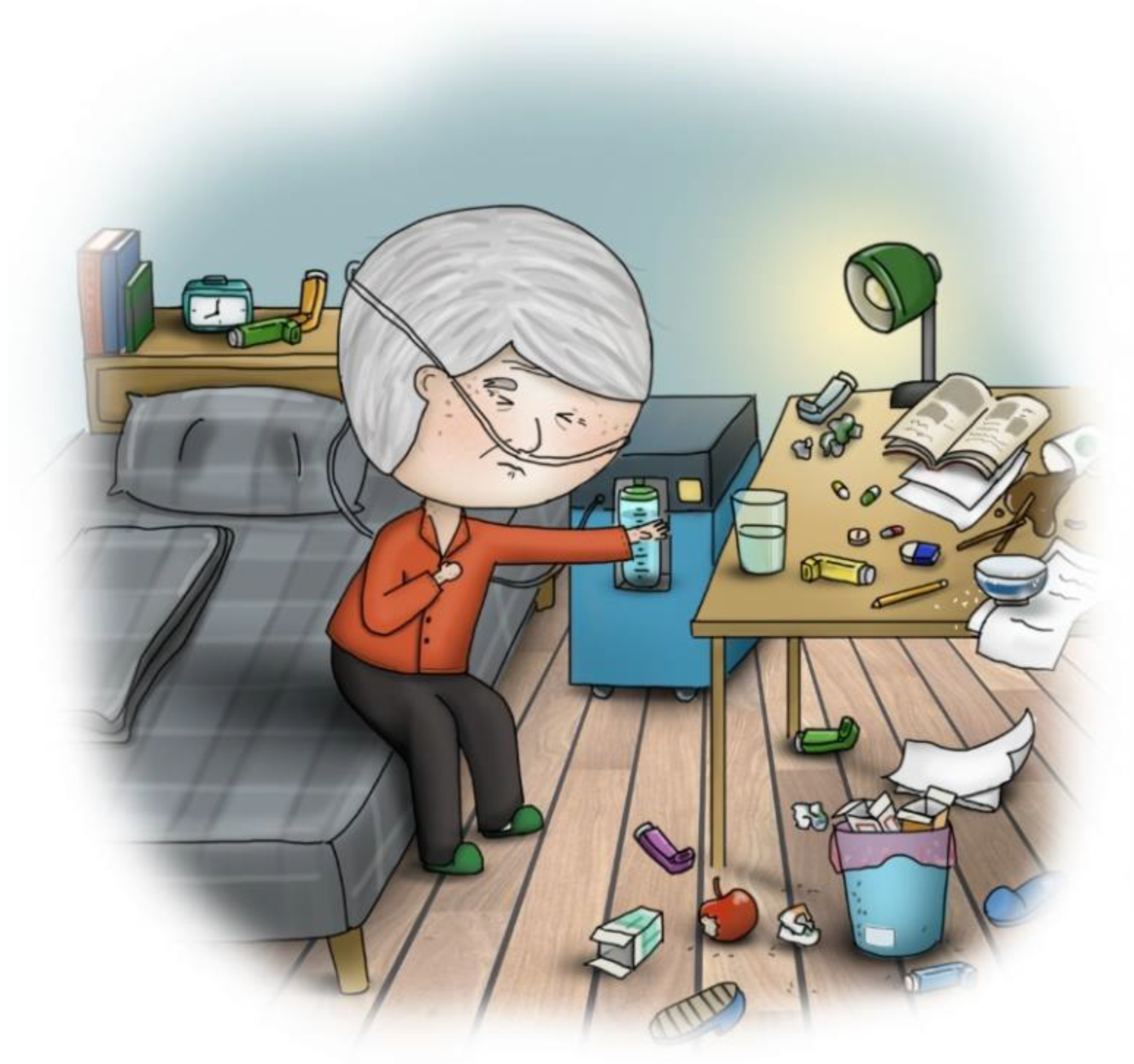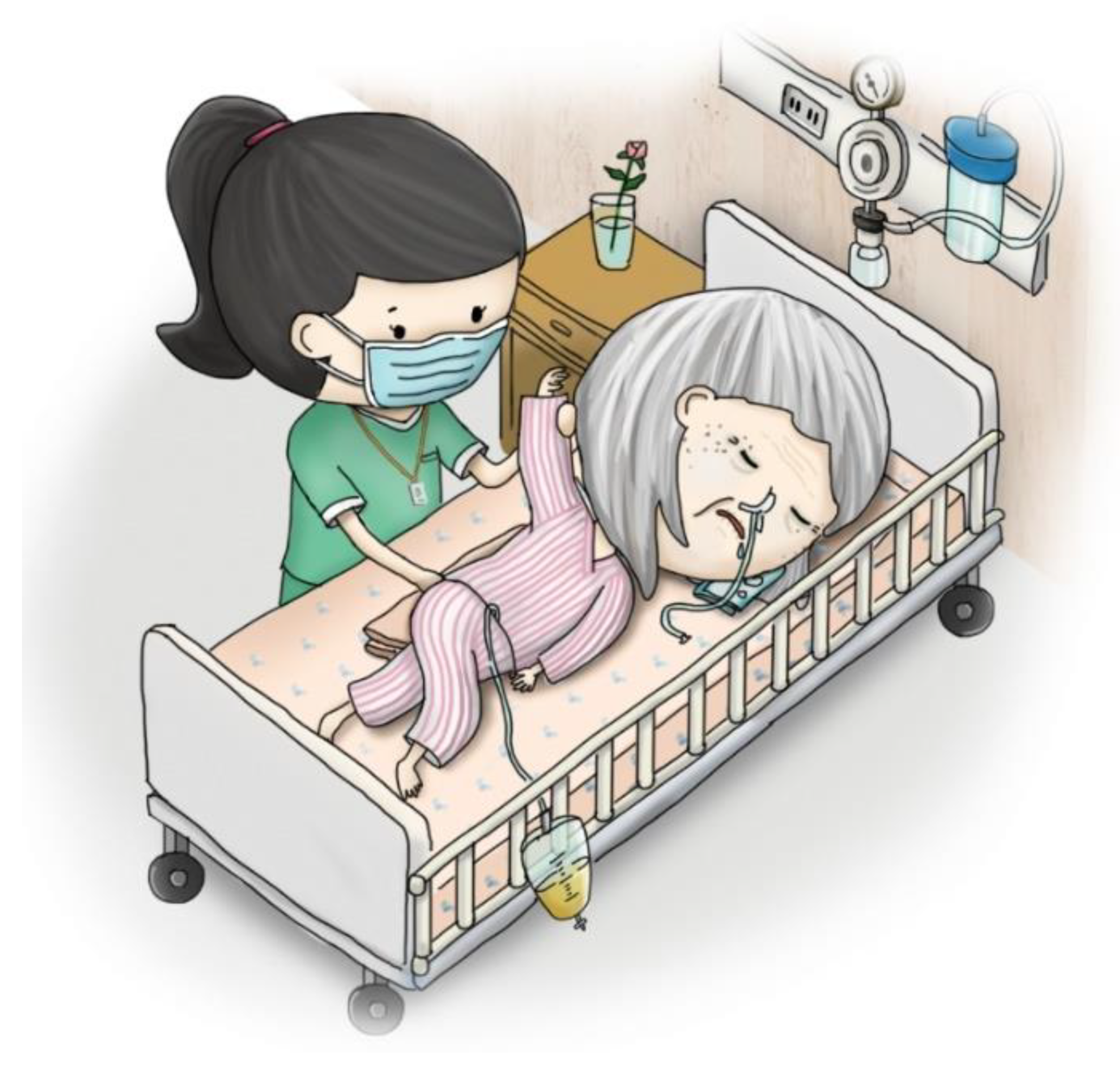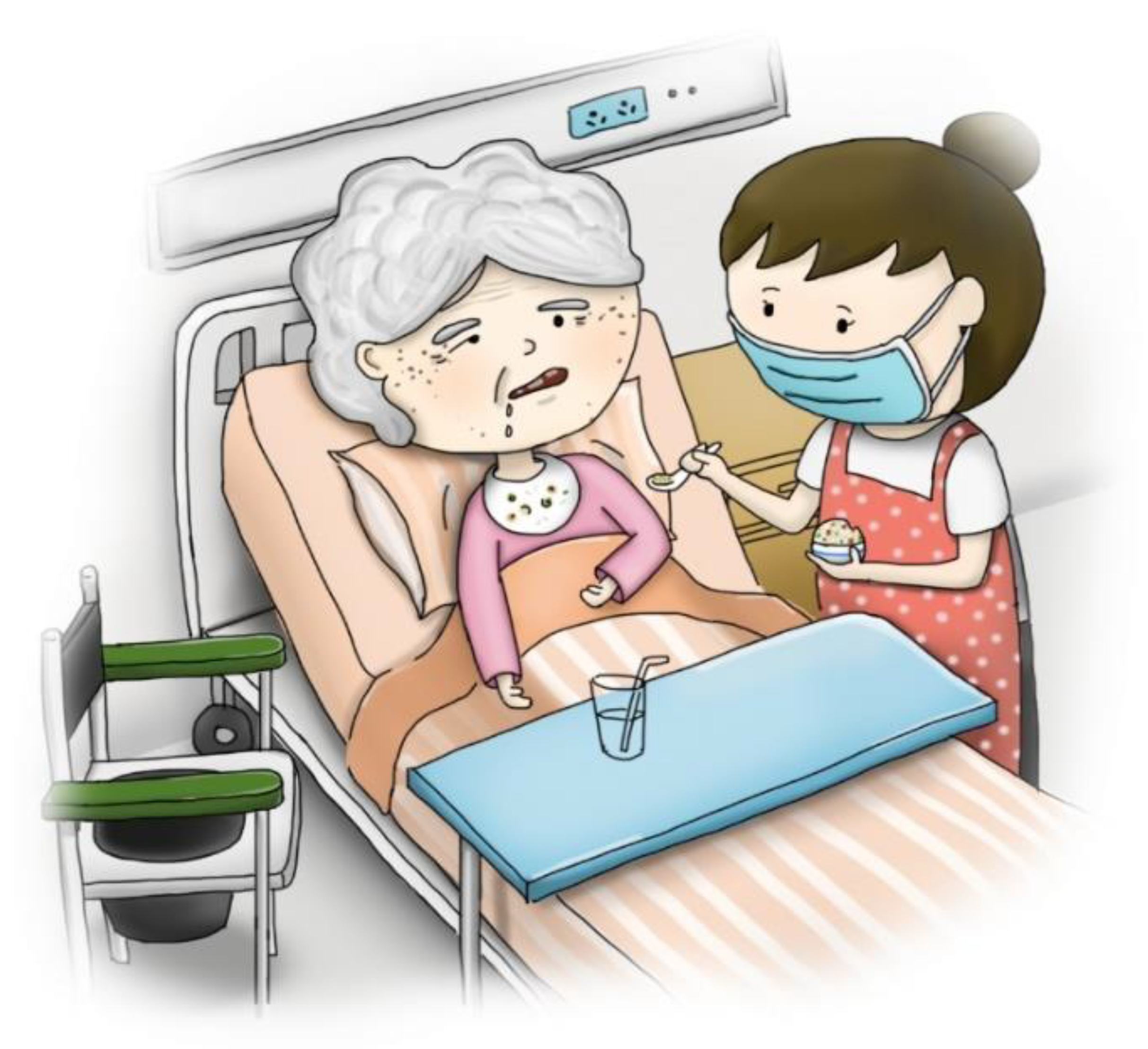Taiwanese Older Adults Prefer to Use Antibiotics and Intravenous Infusion at the End of Life based on a Cartoon Version of the Life Support Preferences Questionnaire
Abstract
1. Introduction
2. Materials and Methods
2.1. Design
2.2. Participants and Settings
2.3. Measurements
- Stage one: This stage involved mailing a structured questionnaire to the experts, explaining the research purpose, and asking them to respond with their opinions on reducing the LSPQ items. Experts agreed to remove only similar scenarios; for example, stroke comprises two scenarios: “no chance of recovery” and “slight chance of recovery”. These experts believed that one of the scenarios could be deleted because “no chance of recovery” or “slight chance of recovery” might not make any difference in very elderly adults. Similarly, they recommended deleting one of the two scenarios related to terminal cancer. Consequently, three scenarios were removed: coma with no chance of recovery, severe stroke with no chance of recovery, and terminal cancer without pain. Regarding medical treatments, the experts recommended splitting artificial nutrition and hydration into two separate items, namely intravenous infusion and nasogastric tube feeding, because of the cultural context of Taiwan. Finally, the first draft of the questionnaire, with six scenarios and five medical treatments, was developed, comprising a total of 30 items.
- Stage two: The six scenarios and five medical treatments were depicted in pictures. The authors repeatedly corresponded with the cartographer regarding the scenarios to be illustrated. After several revisions, five scenario pictures (severe dementia, persistent dyspnea, coma with a slight chance of recovery, severe stroke with a slight chance of recovery, and terminal cancer with pain) were drawn (Figure 2, Figure 3, Figure 4, Figure 5 and Figure 6). Before using these five pictures, the authors invited seven community-dwelling older adults to describe the images they saw. Most of the older adults described Figure 2 as a demented older man who could not find his way home, and Figure 3 as a person who had difficulty breathing and could not get a water cup when he wanted to drink water. Older adults described Figure 4 as a person who was unconscious and could not move by herself, and Figure 5 as an older woman after a stroke who needed help from others to eat and go to the toilet. Regarding Figure 6, most older adults described the person as being very sick and might not survive. The results indicated that these pictures could articulate the five scenarios in LSPQ. For medical treatments, four pictures were adopted to represent antibiotics, CPR, surgery, intravenous infusion, and nasogastric tube feeding [11]. These cartoon pictures and 30 items of the questionnaire constituted the prototype of the questionnaire.
- 3.
- Stage three: Experts were invited to comment on aspects of the draft questionnaire, such as picture colors and text descriptions, and were also required to determine expert validity for the draft questionnaire. The experts used the content validity index (CVI) to assess content validity. The CVI incorporates content suitability and text clarity [16]. The CVI value for content suitability was determined to be 1 for all scenarios. Regarding text clarity, the CVI value was determined to be 0.74 for current health status, 0.77 for severe dementia, 0.77 for persistent dyspnea, 0.85 for coma with a slight chance of recovery, 0.74 for severe stroke with a slight chance of recovery, and 0.74 for terminal cancer with pain. The original LSPQ focuses on the willingness of older adults to undergo gallbladder surgery for gallbladder inflammation [8]. However, during the modification process, the experts mentioned that several older adults had undergone cholecystectomy, and thus suggested that the question for surgery be slightly adjusted to the following: “If you had an inflammation of the gallbladder or another organ, would you be willing to undergo surgery?” Regarding the layout and binding part of the questionnaire, each scenario appeared on the left-hand side of the reader, and the medical treatment appeared on the right-hand side so that the reader could know which clinical scenario they answered. Next, an A4 size thick white non-reflective paper was chosen for the printing. Before recruiting participants, seven older adults from the hospital’s cardiology and hospitalist wards with an education level below elementary school were asked to read a cartoon version of the LSPQ. Older adults said cartoon pictures could increase their understanding of the questionnaire questions.
- 4.
- Stage four: The reliability of the questionnaire was tested by taking older adults over 70 years old as samples. The Cronbach’s alpha coefficient of each section of the questionnaire was as follows: current health status, 0.73; severe dementia, 0.87; persistent dyspnea, 0.84; coma with a slight chance of recovery, 0.90; severe stroke with a slight chance of recovery, 0.91; and terminal cancer with pain, 0.91. The overall Cronbach’s alpha of the questionnaire was 0.97. The results show that the questionnaire has good reliability.
2.4. Data Collection
2.5. Data Analysis
3. Results
4. Discussion
4.1. Discussion
4.2. Limitations
5. Conclusions
6. Practice Implications
Author Contributions
Funding
Institutional Review Board Statement
Informed Consent Statement
Data Availability Statement
Acknowledgments
Conflicts of Interest
References
- United Nations. World Population Ageing 2020 Highlights: Living Arrangements of Older Persons. 2020. Available online: https://www.un.org/development/desa/pd/sites/www.un.org.development.desa.pd/files/undesa_pd-2020_world_population_ageing_highlights.pdf (accessed on 10 September 2022).
- United Nations. World Population Ageing 2019: Highlights. 2019. Available online: https://www.un.org/en/development/desa/population/publications/pdf/ageing/WorldPopulationAgeing2019-Highlights.pdf (accessed on 10 September 2022).
- Ke, L.S.; Huang, X.; Hu, W.Y.; O’Connor, M.; Lee, S. Experiences and perspectives of older people regarding advance care planning: A meta-synthesis of qualitative studies. Palliat. Med. 2017, 31, 394–405. [Google Scholar] [CrossRef] [PubMed]
- Sedini, C.; Biotto, M.; Crespi Bel’skij, L.M.; Moroni Grandini, R.E.; Cesari, M. Advance care planning and advance directives: An overview of the main critical issues. Aging Clin. Exp. Res. 2022, 34, 325–330. [Google Scholar] [CrossRef]
- Timmons, S.; Fox, S.; Drennan, J.; Guerin, S.; Kernohan, W.G. Palliative care for older people with dementia-we need a paradigm shift in our approach. Age Ageing 2022, 51, afac066. [Google Scholar] [CrossRef]
- Venkatasalu, M.R.; Arthur, A.; Seymour, J. Talking about end-of-life care: The perspectives of older South Asians living in East London. J. Res. Nurs. 2013, 18, 394–406. [Google Scholar] [CrossRef]
- Bowman, K.W.; Singer, P.A. Chinese seniors’ perspectives on end-of-life decisions. Soc. Sci. Med. 2001, 53, 455–464. [Google Scholar] [CrossRef] [PubMed]
- Coppola, K.M.; Bookwala, J.; Ditto, P.H.; Lockhart, L.K.; Danks, J.H.; Smucker, W.D. Elderly adults’ preferences for life-sustaining treatments: The role of impairment, prognosis, and pain. Death Stud. 1999, 23, 617–634. [Google Scholar] [PubMed]
- Ditto, P.H.; Danks, J.H.; Smucker, W.D.; Bookwala, J.; Coppola, K.M.; Dresser, R.; Fagerlin, A.; Gready, R.M.; Houts, R.M.; Lockhart, L.K.; et al. Advance directives as acts of communication: A randomized controlled trial. Arch. Intern. Med. 2001, 161, 421–430. [Google Scholar] [CrossRef] [PubMed]
- Ke, L.S.; Hu, W.Y.; Chen, M.J.; Cheng, H.C.; Lin, L.H. Advance care planning to improve end-of-life decision-making consistency between older people and their surrogates in Taiwan. J. Palliat. Med. 2020, 23, 325–336. [Google Scholar] [CrossRef]
- Ke, L.S.; Hu, W.Y.; Chen, C.Y.; Liu, C.Y.; Chiu, T.Y. A quasi-experimental evaluation of advance care planning improves consistency between elderly individuals and their surrogates regarding end-of-life care preferences: Development and application of a decision aid with cartoon pictures. Patient Educ. Couns. 2021, 104, 815–825. [Google Scholar] [CrossRef] [PubMed]
- Abuzahra, N.; Farrah, M.A.-H.; Zalloum, S. Using cartoon in language classroom from a constructivist point of view. AWEJ 2016, Special Issue on CALL, 229–245. [Google Scholar] [CrossRef]
- Bowers, E.S. Fair share contribution cartoons. J. Nutr. Elder. 1988, 7, 37–44. [Google Scholar] [CrossRef] [PubMed]
- Mediouni, M.; Schlatterer, D.R.; Khoury, A. Revisiting an old strategy: Cartoons in medical education. J. Vis. Commun. Med. 2019, 42, 26–30. [Google Scholar] [CrossRef] [PubMed]
- de Villiers, M.R.; de Villiers, P.J.; Kent, A.P. The Delphi technique in health sciences education research. Med. Teach. 2005, 27, 639–643. [Google Scholar] [CrossRef] [PubMed]
- Almanasreh, E.; Moles, R.; Chen, T.F. Evaluation of methods used for estimating content validity. Res. Soc. Adm. Pharm. 2019, 15, 214–221. [Google Scholar] [CrossRef]
- Rouquette, A.; Falissard, B. Sample size requirements for the internal validation of psychiatric scales. Int. J. Methods Psychiatr. Res. 2011, 20, 235–249. [Google Scholar] [CrossRef]
- Ke, L.S.; Hu, W.Y.; Dai, Y.T.; Chen, C.Y. The differences and perspectives between elderly individuals and their surrogates regarding end-of-life care: A mixed methods study. Am. J. Hosp. Palliat. Care 2022, 39, 1061–1070. [Google Scholar] [CrossRef] [PubMed]
- Yip, K.F.; Wong, T.H.; Alhamid, S.M.; Nadkarni, N.; Tan, C.K.G.; Pang, A.; Seow, C.C.D. Integrating advance care planning as part of comprehensive geriatric assessment for hospitalised frail elderly patients: Findings of a cross-sectional study. Singap. Med. J. 2020, 61, 254–259. [Google Scholar] [CrossRef] [PubMed]
- Kim, J.; Heo, S.; Hong, S.W.; Shim, J.; Lee, J.A. Correlates of advance directive treatment preferences among community-dwelling older people with chronic diseases. Int. J. Older People Nurs. 2019, 14, e12229. [Google Scholar] [CrossRef] [PubMed]
- Hsu, Y.H.; Chou, M.Y.; Chen, H.M.; Chang, W.C.; Chu, C.S.; Wang, Y.C.; Hsu, C.L.; Liang, C.K.; Lee, C.C.; Lin, Y.T. The trend of aggressive treatments in end-of-life care for older people with dementia after a policy change in Taiwan. J. Am. Med. Dir. Assoc. 2020, 21, 858–863.e1. [Google Scholar] [CrossRef] [PubMed]
- Lin, L.; Sun, R.; Yao, T.; Zhou, X.; Harbarth, S. Factors influencing inappropriate use of antibiotics in outpatient and community settings in China: A mixed-methods systematic review. BMJ Glob. Health 2020, 5, e003599. [Google Scholar] [CrossRef] [PubMed]
- Ye, D.; Chang, J.; Yang, C.; Yan, K.; Ji, W.; Aziz, M.M.; Gillani, A.H.; Fang, Y. How does the general public view antibiotic use in China? Result from a cross-sectional survey. Int. J. Clin. Pharm. 2017, 39, 927–934. [Google Scholar] [CrossRef] [PubMed]
- Ngan, O.M.Y.; Bergstresser, S.M.; Sanip, S.; Emdadul Haque, A.T.M.; Chan, H.Y.L.; Au, D.K.S. Cultural considerations in forgoing enteral feeding: A comparison between the Hong Kong Chinese, North American, and Malaysian Islamic patients with advanced dementia at the end-of-life. Dev. World Bioeth. 2020, 20, 105–114. [Google Scholar] [CrossRef] [PubMed]
- Wang, H.; Xie, X.; Liu, Z.; Yang, Z. Evaluation of the inpatient usage of intravenous infusion in 156 hospitals. J. Pharm. Pract. 2017, 35, 573–576. [Google Scholar]
- Zeng, S.; Wang, D.; Liu, W.; Yan, Y.; Zhu, M.; Gong, Z.; Sun, S. Overuse of intravenous infusions in China: Focusing on management platform and cultural problems. Int. J. Clin. Pharm. 2019, 41, 1133–1137. [Google Scholar] [CrossRef]
- Kan, J.; Zhu, X.; Wang, T.; Lu, R.; Spencer, P.S. Chinese patient demand for intravenous therapy: A preliminary survey. Lancet 2015, 386, S61. [Google Scholar] [CrossRef]
- Ke, L.S.; Chiu, T.Y.; Lo, S.S.; Hu, W.Y. Knowledge, attitudes, and behavioral intentions of nurses toward providing artificial nutrition and hydration for terminal cancer patients in Taiwan. Cancer Nurs. 2008, 31, 67–76. [Google Scholar] [CrossRef]
- Gao, G. Self and other: A Chinese perspective on interpersonal relationships. In Communication in Personal Relationships Across Cultures; Gudykunst, W.B., Ting-Toomey, S., Nishida, T., Eds.; Sage Publications: Thousand Oaks, CA, USA, 1996; pp. 81–85. [Google Scholar]
- Ke, L.S.; Hu, W.Y.; Dai, Y.T.; Chen, C.Y. Factors influencing older adults’ end-of-life care preferences. J. Hosp. Palliat. Nurs. 2022, 24, E205–E211. [Google Scholar] [CrossRef] [PubMed]
- Borrat-Besson, C.; Vilpert, S.; Borasio, G.D.; Maurer, J. Views on a “good death”: End-of-life preferences and their association with socio-demographic characteristics in a representative sample of older adults in Switzerland. OMEGA-J. Death Dying 2022, 85, 409–428. [Google Scholar] [CrossRef] [PubMed]
- Gott, M.; Frey, R.; Wiles, J.; Rolleston, A.; Teh, R.; Moeke-Maxwell, T.; Kerse, N. End of life care preferences among people of advanced age: LiLACS NZ. BMC Palliat. Care 2017, 16, 76. [Google Scholar] [CrossRef]
- Wong, A.D.; Phillips, S.P. Gender disparities in end of life care: A scoping review. J. Palliat. Care 2023, 38, 78–96. [Google Scholar] [CrossRef]
- Park, J.Y.; Lim, C.Y.; Puurveen, G.; Kim, D.Y.; Lee, J.H.; Do, H.H.; Kim, K.S.; Yoo, K.D.; Kim, H.J.; Kim, Y.; et al. Effect of the contents in advance directives on individuals’ decision-making. OMEGA-J. Death Dying 2020, 81, 436–453. [Google Scholar] [CrossRef] [PubMed]
- Tan, W.S.; Bajpai, R.; Ho, A.H.Y.; Low, C.K.; Car, J. Retrospective cohort analysis of real-life decisions about end-of-life care preferences in a Southeast Asian country. BMJ Open 2019, 9, e024662. [Google Scholar] [CrossRef]
- Mead, G.E.; O’Keeffe, S.T.; Jack, C.I.; Maèstri-Banks, A.M.; Playfer, J.R.; Lye, M. What factors influence patient preferences regarding cardiopulmonary resuscitation? J. R. Coll. Physicians Lond. 1995, 29, 295–298. [Google Scholar] [PubMed]
- O’Mahony, S.; Kittelson, S.; Barker, P.C.; Delgado Guay, M.O.; Yao, Y.; Handzo, G.F.; Chochinov, H.M.; Fitchett, G.; Emanuel, L.L.; Wilkie, D.J. Association of race with end-of-life treatment preferences in older adults with cancer receiving outpatient palliative care. J. Palliat. Med. 2021, 24, 1174–1182. [Google Scholar] [CrossRef] [PubMed]
- Frechman, E.; Dietrich, M.S.; Walden, R.L.; Maxwell, C.A. Exploring the uptake of advance care planning in older Adults: An integrative review. J. Pain Symptom Manag. 2020, 60, 1208–1222.e59. [Google Scholar] [CrossRef] [PubMed]
- van Dyck, L.I.; Paiva, A.; Redding, C.A.; Fried, T.R. Understanding the role of knowledge in advance care planning engagement. J. Pain Symptom Manag. 2021, 62, 778–784. [Google Scholar] [CrossRef] [PubMed]






| Variables | n (%) | Total Score of LSPQ M (SD) | Antibiotics M (SD) | CPR M (SD) | Surgery M (SD) | IV M (SD) | NG Feeding M (SD) |
|---|---|---|---|---|---|---|---|
| Participant sources | t = 0.902 | t = 0.076 | t = −0.542 | t = 1.529 | t = −0.075 | t = 1.674 | |
| Elderly patients | 268 (78.4) | 86.42 (25.52) | 20.37 (5.32) | 13.75 (6.85) | 16.99 (5.89) | 20.02 (6.02) | 15.48 (6.65) |
| Elderly family members | 74 (21.6) | 89.63 (29.41) | 20.42 (5.81) | 13.25 (6.90) | 18.21 (6.30) | 19.96 (6.40) | 17.00 (7.36) |
| Gender | t = −3.301 *** | t = −2.225 * | t = −3.884 *** | t = −3.081 ** | t = −2.022 * | t = −3.309 ** | |
| Female | 129 (37.7) | 81.07 (25.48) | 19.55 (5.67) | 11.91 (5.87) | 15.98 (5.98) | 19.15 (6.27) | 14.24 (6.86) |
| Male | 213 (62.3) | 90.79 (26.28) | 20.89 (5.20) | 14.71 (7.19) | 18.03 (5.88) | 20.53 (5.93) | 16.75 (6.64) |
| Age | t = −2.025 * | t = −2.197 * | t = −2.640 ** | t = −0.930 | t = −2.339 * | t = −0.699 | |
| 70–79 | 182 (53.2) | 84.32 (25.91) | 19.77 (5.46) | 12.71 (6.27) | 16.97 (5.70) | 19.28 (6.25) | 15.55 (6.94) |
| ≥80 | 160 (46.8) | 90.17 (26.61) | 21.06 (5.29) | 14.69 (7.32) | 17.58 (6.31) | 20.83 (5.82) | 16.08 (6.70) |
| Education level | F = 2.108 | F = 0.094 | F = 6.550 ** | F = 4.114 * | F = 0.108 | F = 2.555 | |
| Elementary school and below | 151 (44.8) | 86.00 (25.12) | 20.21 (5.32) | 13.09 (6.61) | 16.99 (5.70) | 20.15 (6.23) | 15.50 (6.86) |
| Secondary school | 103 (30.6) | 84.23 (23.95) | 20.51 (5.23) | 12.43 (6.21) | 16.31 (5.64) | 19.85 (5.59) | 15.00 (6.38) |
| Higher education | 83 (24.6) | 91.99 (30.84) | 20.41 (5.92) | 15.85 (7.53) | 18.80 (6.78) | 19.83 (6.55) | 17.21 (7.29) |
| Marital status | F = 1.262 | F = 1.073 | F = 1.538 | F = 2.177 | F = 1.196 | F = 0.959 | |
| Single | 18 (5.3) | 93.71 (24.46) | 22.29 (5.98) | 14.41 (7.66) | 17.53 (5.71) | 22.71 (4.38) | 16.76 (7.27) |
| Married/relationship | 222 (65.9) | 88.17 (26.62) | 20.34 (5.22) | 14.06 (7.03) | 17.78 (5.98) | 19.83 (6.04) | 16.06 (6.82) |
| Divorced | 18 (5.3) | 85.11 (31.34) | 21.00 (7.36) | 11.89 (6.17) | 16.39 (5.91) | 19.67 (7.81) | 16.17 (8.73) |
| Widowed | 79 (23.4) | 82.62 (24.86) | 19.81 (5.38) | 12.44 (6.21) | 15.84 (6.10) | 19.87 (6.14) | 14.66 (6.42) |
| Living condition | F = 0.029 | F = 0.965 | F = 0.524 | F = 0.373 | F = 0.481 | F = 1.204 | |
| Living with family | 278 (83.0) | 86.93 (27.89) | 20.17 (5.45) | 13.66 (6.99) | 17.32 (6.19) | 19.84 (6.24) | 15.88 (6.97) |
| Living in long-term care facility | 28 (8.4) | 85.62 (19.20) | 20.73 (4.78) | 12.23 (4.88) | 16.31 (4.58) | 20.15 (4.51) | 16.19 (6.21) |
| Living alone | 29 (8.7) | 86.76 (23.93) | 21.59 (5.80) | 13.41 (7.00) | 16.90 (5.60) | 21.00 (6.26) | 13.86 (6.20) |
| Religion | F = 0.142 | F = 0.148 | F = 0.579 | F = 0.328 | F = 0.409 | F = 0.469 | |
| None | 67 (20.1) | 88.12 (27.83) | 20.42 (5.62) | 14.49 (7.18) | 17.05 (6.59) | 19.68 (6.05) | 15.98 (6.50) |
| Buddhism | 147 (44.0) | 86.09 (25.48) | 20.41 (5.38) | 13.55 (6.86) | 17.10 (5.68) | 19.71 (5.87) | 15.31 (6.65) |
| Taoism | 78 (23.4) | 86.89 (26.48) | 20.00 (5.03) | 12.97 (6.73) | 17.21 (5.72) | 20.59 (6.50) | 16.36 (7.48) |
| Christian/Catholic | 42 (12.6) | 88.53 (28.46) | 20.63 (6.30) | 13.51 (6.78) | 17.95 (6.79) | 20.22 (6.54) | 16.21 (7.20) |
| Variable (Range 1–5 Points) | Mean (SD) | Ranking |
|---|---|---|
| Currently healthy | ||
| Antibiotics | 4.20 (0.87) | 5 |
| Cardiopulmonary resuscitation | 2.62 (1.43) | 1 |
| Surgery | 3.65 (1.11) | 3 |
| Intravenous infusion | 3.99 (1.02) | 4 |
| Nasogastric tube feeding | 2.99 (1.34) | 2 |
| Severe dementia | ||
| Antibiotics | 3.58 (1.18) | 5 |
| Cardiopulmonary resuscitation | 2.38 (1.37) | 1 |
| Surgery | 3.03 (1.27) | 3 |
| Intravenous infusion | 3.47 (1.25) | 4 |
| Nasogastric tube feeding | 2.72 (1.30) | 2 |
| Persistent dyspnea | ||
| Antibiotics | 3.77 (1.03) | 5 |
| Cardiopulmonary resuscitation | 2.39 (1.32) | 1 |
| Surgery | 3.05 (1.17) | 3 |
| Intravenous infusion | 3.55 (1.13) | 4 |
| Nasogastric tube feeding | 2.79 (1.29) | 2 |
| Coma with a slight chance of recovery | ||
| Antibiotics | 2.99 (1.35) | 4 |
| Cardiopulmonary resuscitation | 2.16 (1.26) | 1 |
| Surgery | 2.60 (1.29) | 3 |
| Intravenous infusion | 3.06 (1.35) | 5 |
| Nasogastric tube feeding | 2.48 (1.30) | 2 |
| Severe stroke with a slight chance of recovery | ||
| Antibiotics | 3.06 (1.33) | 4 |
| Cardiopulmonary resuscitation | 2.16 (1.22) | 1 |
| Surgery | 2.64 (1.24) | 3 |
| Intravenous infusion | 3.07 (1.31) | 5 |
| Nasogastric tube feeding | 2.51 (1.28) | 2 |
| Terminal cancer with pain | ||
| Antibiotics | 2.78 (1.38) | 4 |
| Cardiopulmonary resuscitation | 1.98 (1.19) | 1 |
| Surgery | 2.33 (1.25) | 2 |
| Intravenous infusion | 2.87 (1.38) | 5 |
| Nasogastric tube feeding | 2.33 (1.27) | 3 |
| Gender | X2 | p | ||
|---|---|---|---|---|
| Female n (%) | Male n (%) | |||
| Age | 13.366 | <0.001 | ||
| 70–79 | 85 (46.7) | 97 (53.3) | ||
| ≥80 | 44 (27.5) | 116 (72.5) | ||
| Education level | 25.586 | <0.001 | ||
| Elementary school and below | 77 (51.0) | 74 (49.0) | ||
| Secondary school | 35 (34.0) | 68 (66.0) | ||
| Higher education | 15 (18.1) | 68 (81.9) | ||
Disclaimer/Publisher’s Note: The statements, opinions and data contained in all publications are solely those of the individual author(s) and contributor(s) and not of MDPI and/or the editor(s). MDPI and/or the editor(s) disclaim responsibility for any injury to people or property resulting from any ideas, methods, instructions or products referred to in the content. |
© 2023 by the authors. Licensee MDPI, Basel, Switzerland. This article is an open access article distributed under the terms and conditions of the Creative Commons Attribution (CC BY) license (https://creativecommons.org/licenses/by/4.0/).
Share and Cite
Ke, L.-S.; Cheng, H.-C.; Liu, C.-L.; Ku, Y.-C.; Lee, M.-J.; Lin, Y.-L.; Huang, H.-Y. Taiwanese Older Adults Prefer to Use Antibiotics and Intravenous Infusion at the End of Life based on a Cartoon Version of the Life Support Preferences Questionnaire. Int. J. Environ. Res. Public Health 2023, 20, 3430. https://doi.org/10.3390/ijerph20043430
Ke L-S, Cheng H-C, Liu C-L, Ku Y-C, Lee M-J, Lin Y-L, Huang H-Y. Taiwanese Older Adults Prefer to Use Antibiotics and Intravenous Infusion at the End of Life based on a Cartoon Version of the Life Support Preferences Questionnaire. International Journal of Environmental Research and Public Health. 2023; 20(4):3430. https://doi.org/10.3390/ijerph20043430
Chicago/Turabian StyleKe, Li-Shan, Hui-Chuan Cheng, Chien-Liang Liu, Yu-Chen Ku, Ming-Ju Lee, Yin-Ling Lin, and Hsiu-Ying Huang. 2023. "Taiwanese Older Adults Prefer to Use Antibiotics and Intravenous Infusion at the End of Life based on a Cartoon Version of the Life Support Preferences Questionnaire" International Journal of Environmental Research and Public Health 20, no. 4: 3430. https://doi.org/10.3390/ijerph20043430
APA StyleKe, L.-S., Cheng, H.-C., Liu, C.-L., Ku, Y.-C., Lee, M.-J., Lin, Y.-L., & Huang, H.-Y. (2023). Taiwanese Older Adults Prefer to Use Antibiotics and Intravenous Infusion at the End of Life based on a Cartoon Version of the Life Support Preferences Questionnaire. International Journal of Environmental Research and Public Health, 20(4), 3430. https://doi.org/10.3390/ijerph20043430






